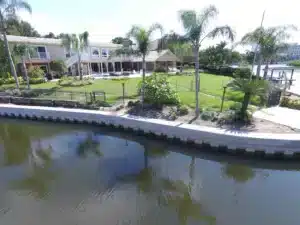The term “seawall” is commonly used interchangeably with “bulkhead.” While both seawalls and bulkheads have similarities, they’re actually two different stabilization structures.
If you have a waterfront property, you’ll want to know when to choose a bulkhead vs. seawall when protecting it with the right shoreline stabilization structures. This guide will walk through the difference between bulkheads and seawalls and the strengths of each structure so you can make the best choice for your waterfront property.

What Is a Bulkhead?
A bulkhead is a vertical shoreline stabilization structure designed to prevent soil erosion and is frequently used at marinas. It’s like a shield that protects against the constant wear and tear of water and waves along the coastline. Bulkheads provide a minimal amount of protection against wave overtopping.
The vertical structures can be constructed from various materials, including steel sheet piling, timber, vinyl, and aluminum. Each material has its advantages and disadvantages. For example, steel is strong and durable but can be expensive, while timber is more affordable but may not last as long.
Bulkheads are usually smaller structures that are built into the ground, while seawalls are larger and more complex structures that may require extensive engineering and construction.
The most common types of bulkhead design include:
- Cantilevered bulkheads (the simplest, consisting of a wall of sheet piling)
- Anchored bulkheads (anchored sheet piling walls used at waterfront areas to prevent soil erosion and create an area suitable for docking)
- Gravity bulkheads (rock-filled timber cribs and sheet-pile cells that use the weight and the width of their bases to maintain stability)
Benefits of Bulkheads
Bulkheads offer numerous benefits for waterfront property owners, including:
- Preventing soil erosion
- Protecting frontline waters
- Stabilizing the shoreline
- Retaining earth pressures
- Enhancing property value
A well-designed bulkhead can help preserve your property for years to come, even in the face of harsh marine environments.
Harbor Exports offers marine-grade lumber, vinyl, hardwood, steel panels, vinyl, and composite material options to build your bulkhead.
What Is a Seawall?
While bulkheads are designed to retain soil, seawalls take things a step further by protecting the shoreline from the direct impact of waves and storm surges. Seawalls are structures built parallel to the shore, designed to resist the force of waves and prevent coastal erosion.
There are several types of seawalls, each with its own unique design and purpose. The most common types include vertical, curved, mound, and revetments.
Seawalls can be constructed from a variety of materials, including vinyl, steel sheet piling, timber, or geotextile tubes. Concrete is the most common material used for seawalls due to its durability and ability to withstand the constant pounding and pressure of waves. However, other materials like stone and steel can also be effective, depending on the specific needs of your property.
Benefits of Seawalls
A properly designed and constructed seawall can provide peace of mind, knowing your property is protected from the worst waves the ocean can dish out. Seawalls offer numerous benefits for waterfront property owners, including:
- Protecting against wave overtopping and coastal storm events
- Preventing coastal erosion
- Stabilizing the shoreline
- Enhancing property value
- Providing a barrier against flooding
Due to their larger size and more complex design, seawalls are generally more expensive to construct than bulkheads. They also require more ongoing maintenance to ensure they remain effective over time. However, the added cost and maintenance of a seawall may be necessary for properties that face severe coastal conditions and require the highest level of protection.
Seawall Building Options from Harbor Exports
Harbor Exports offers several options for building seawalls, including marine lumber and convenient preformed vinyl panels.
Marine-Grade Lumber
Hardwoods and pressure-treated softwoods have an attractive, natural appearance that can withstand harsh marine environments for many years. Exotic hardwoods, including ipe, garapa, and tigerwood, resist rot, decay, and marine organisms. They also have high strength-to-weight ratios, making them ideal for construction projects under loads, such as seawalls and docks. Harbor Exports also supplies premium-quality, pressure-treated marine lumber that will last for decades, even under harsh conditions.
Vinyl Seawalls
Vinyl seawalls provide quite a few overall benefits. They’re cost-efficient, provide a consistent appearance over time against the harsh marine environment, are UV and marine borer-resistant, are easy to install, have a long lifespan, and are very durable.
Harbor Exports offers Vanguard and ESP vinyl seawall products in various sizes, and they come with strong warranties. Vinyl is a great building material choice if you’re looking to build a seawall!
And don’t forget your stainless steel seawall hardware; we supply all types of galvanized and stainless steel marine hardware. We can provide the necessary hardware to complete the project no matter what type of seawall materials you choose.
Choosing Between a Bulkhead and Seawall
When deciding between a bulkhead and seawall for your waterfront property, consider your property’s specific location and conditions, your budget and long-term costs, and your personal aesthetic preferences. The professionals at Harbor Exports can help you make an educated decision and guide you on the right materials.
Property Location and Conditions
Conducting a thorough marine environment analysis is crucial. You don’t want to invest in a structure that’s not equipped to handle the specific challenges of your location. Is your shoreline exposed to intense wave action or more mild conditions? What’s the soil composition like — sandy, rocky, or something else entirely?
These site-specific factors will heavily influence whether a bulkhead or seawall is the optimal choice. As discussed earlier, bulkheads are best for calmer waters and limited wave action, and seawalls withstand more severe coastal conditions and storm surges.
Budget and Long-term Costs
Of course, your budget is another major consideration. While bulkheads may have a lower upfront cost, that doesn’t necessarily mean they’re the most cost-effective choice in the long run. Seawalls, though pricier initially, often provide superior protection and durability. Over time, this can translate to lower maintenance and repair costs.
It’s important to look at the big picture and consider the total lifecycle costs of each option. For example, if your property or land is in a high-risk coastal area, a seawall would provide the best long-term value and protection.
Aesthetic Preferences
While function should always come first, the visual impact of your shoreline structure matters, too. Some property owners prefer the rugged, natural look of a rock-filled timber bulkhead. Others are drawn to the clean lines and modern appearance of a steel or concrete seawall.
Contact Harbor Exports for Professional Bulkhead and Seawall Marine Construction
Investing in the proper shoreline protection is crucial for preserving your waterfront oasis, and hiring qualified experts who know the ins and outs of marine construction is absolutely essential for the success of your bulkhead or seawall project.
The experienced marine contractors at Harbor Exports understand the unique challenges of waterfront construction and have the knowledge and skills to assess your site conditions. Our team can recommend a structure made of the best material that will weather the elements and withstand the test of time.
Ensure your property is protected by the right structure for your specific marine construction needs. Call the experts for your building project at Harbor Exports today!
- About the Author
- Recent Posts
Brad Enfinger has been in construction for over 20 years and has been involved with every material from concrete slab to laying the roof on houses. Brad’s diverse experience has given him the knowledge needed to assist those with shipping building materials, whether it be a house, pole barn, deck, or a dock. Brad at Harbor Exports has anything for your building material needs and can export material all over the world.



